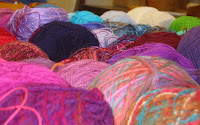
This slightly out of focus picture shows my happy start to a new year. Back a few months ago, when money wasn't so tight, I purchased something that had been on my wishlist for a looong time - a set of cases for my collection of Handwoven Magazines. They arrived several months ago, and sat in a box. I was slightly disappointed with my purchase - they came with labels that needed to be applied, unlike the cases I bought several years ago for my Weavers issues - those have the title embossed nicely directly on the case. Still, they are MUCH nicer than the magazine holders I was using before, so it felt really good to finally get the labels applied and the magazines transferred.
My goal for 2009 is to get unstuck, so this seemed like a great start. I love the nice, organized look of my shelf, right behind me as I sit at the loom. (You can just see the corner of the breast beam in the bottom left of the photo.)
For almost the last year, I've been divesting myself of things I seldom use. Not all things, of course, because hope springs eternal. I sold a small triangle loom, my table loom, my previous marudai. I sold a lot of old Weavers Journal and Handweaver and Craftsman issues on ebay. I actually let all of my magazine subscriptions lapse, and even all of my memberships except for my local guild. (I may end up rejoining some organizations, though not right away.)
And yet, I still have two wonderful looms (32 shaft Megado and 8 shaft David), a warping wheel and squirrel swift cage and floor inkle loom, my Lendrum spinning wheel, a charka and a collection of spindles, my takadai and marudai. Now that the first outbreath phase is complete, I want to get better organized and make a concerted effort to actually USE all of my other toys! (That's my biggest problem in life - I THINK about doing a lot of things, but seldom even get things out of my head and onto paper, much less manifest them into something real.)
It will be interesting to see if this phase is followed by an inbreath phase. There was a time when I seemed to continually be acquiring - tools, cones of yarn, anything fibery. I do still get tempted on ebay, but not nearly as much as before. I must say, I'm pretty happy with what I've already got!
Last year, a member of our guild wrote an article on "How to Tell When You Are No Longer a Beginning Weaver", and she asked for suggestions from members. I had a few contributions.
You are no longer a beginner when ...
- you know to take a pair of scissors to a workshop even if it isn't on the supply list
- you no longer feel giddy at the prospect of being given a free loom or wheel or cone of yarn
- when asked your favorite weaving books, Learning to Weave is no longer your only answer.
Happy New Year! I wish you a joyful 2009, filled with lots of playtime with your fibers and toys and friends.

















































